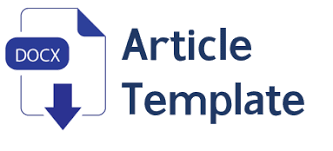Perfect Ear pada Minat dan Hasil Belajar Siswa dalam Seni Musik
Abstract
Penelitian ini bertujuan untuk menguji pengaruh penggunaan aplikasi Perfect Ear dalam pembelajaran seni musik dan mengatasi kendala kurangnya pemahaman siswa terhadap teori musik dasar serta rendahnya minat belajar dalam bidang seni musik di SMAN 1 Talun Kabupaten Blitar. Penelitian ini diharapkan memberikan kontribusi dalam pengembangan metode pembelajaran musik yang inovatif serta pemanfaatan teknologi yang mendukung pembelajaran musik yang lebih efektif dan interaktif. Metode penelitian yang digunakan adalah uji Kuantitatif Eksperimen dengan desain One Group Pretest-Post Test, yang bertujuan untuk mengevaluasi pengaruh positif dari penggunaan aplikasi Perfect Ear. Selain itu penelitian ini menganalisis minat siswa dalam pembelajaran seni musik melalui kuesioner ulasan pengguna. Hasil dari penelitian ini menunjukkan bahwa terdapat peningkatan yang signifikan dalam prestasi belajar siswa berdasarkan perbandingan nilai Pre-Test dan Post Test, dengan rata-rata sebesar 85,43 yang melebihi nilai ketuntasan minimum yang telah ditentukan. Penelitian ini menunjukkan bahwa penggunaan aplikasi Perfect Ear memiliki pengaruh positif dan signifikan terhadap pemahaman teori musik dasar siswa. Secara keseluruhan, aplikasi Perfect Ear dapat dianggap sebagai alat yang efektif dalam meningkatkan pembelajaran musik dengan memberikan pengalaman pembelajaran yang menarik dan berarti bagi siswa. Penelitian ini memiliki batasan dalam menggali pengaruh jangka panjang pemanfaatan aplikasi Perfect Ear pada siswa, sehingga penelitian lanjutan diperlukan untuk memberikan pemahaman yang lebih komprehensif dan kontribusi dalam evaluasi dan pengembangan metode pembelajaran musik yang inovatif untuk mendukung pembelajaran musik yang lebih efektif.
Perfect Ear on Students' Interest and Learning Outcomes in Music Studies
This study aims to examine the influence of using the Perfect Ear application in music education and address the challenges of students' lack of understanding of basic music theory and low interest in the field of music at SMAN 1 Talun Kabupaten Blitar. The research is anticipated to aid in the creation of innovative approaches to teaching music as well as the application of technology to assist more efficient and engaging music education. In order to assess the beneficial impacts of the application, a quantitative experimental design with a one-group pretest-posttest technique was used in the research. Through a user review questionnaire, the research also assesses students’ interest in music education. The results indicate positive feedback from users of the Perfect Ear application. Moreover, there is a significant improvement in students' learning outcomes based on the comparison of Pre-Test and Post-Test scores, with an average of 85.43, surpassing the minimum passing grade. The study reveals that the use of the Perfect Ear application has a significant and positive influence on students' understanding of basic music theory. Overall, the Perfect Ear application can be considered an effective tool to enhance music education by providing engaging and meaningful learning experiences for students. However, the study is limited in exploring the long-term effects of utilizing the Perfect Ear application, warranting further research to gain a comprehensive understanding and contribute to the evaluation and development of innovative music teaching methods that support more effective music education.
Full Text:
PDFReferences
Anikina, O. V., & Yakimenko, E. V. (2015). Edutainment as a Modern Technology of Education. Procedia - Social and Behavioral Sciences, 166, 475–479. https://doi.org/10.1016/j.sbspro.2014.12.558
Bourgonjon, J., Valcke, M., Soetaert, R., & Schellens, T. (2010). Students’ perceptions about the use of video games in the classroom. Computers & Education, 54(1145–1156), 1–13.
Espinosa, L. E. (2020). Gamification Strategies for Music Educators: an Online Continuing Education Course. Orphanet Journal of Rare Diseases, 21(1).
Hawlitschek, A., & Joeckel, S. (2017). Increasing the effectiveness of digital educational games: The effects of a learning instruction on students’ learning, motivation and cognitive load. Computers in Human Behavior, 72, 79–86. https://doi.org/10.1016/j.chb.2017.01.040
Rohmawati, A. (2015). Efektivitas Pembelajaran. Jurnal Pendidikan Usia Dini, 9(1), 15–32.
Sumatri, M. S. (2015). Strategi Pembelajaran. Rajagrafindo Persada
Hake, R. R. (1999). Analyzing Change/Gain Scores. https://web.physics.indiana.edu/sdi/AnalyzingChange-Gain.pdf
Hanus, M. D., & Fox, J. (2015). Assessing the effects of gamification in the classroom: A longitudinal study on intrinsic motivation, social comparison, satisfaction, effort, and academic performance. Computers and Education, 80, 152–161. https://doi.org/10.1016/j.compedu.2014.08.019
Beed, P. L., Hawkins, E. M., & Roller, C. M. (1991). Moving learners toward independence: the power of scaffolded instruction. The Reading Teacher, 44, 648e655. http://dx.doi.org/10.2307/20200767
DOI: https://doi.org/10.24821/idea.v17i2.10021
DOI (PDF): https://doi.org/10.24821/idea.v17i2.10021.g3315
Refbacks
- There are currently no refbacks.
___________________________________________________________
IDEA: Jurnal Ilmiah Seni Pertunjukan
ISSN 1411-6472
Published by Institut Seni Indonesia Yogyakarta
Website: https://journal.isi.ac.id/index.php/IDEA



